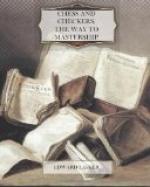What has been said of irregular replies which Black may try in King’s Pawn openings holds good in Queen’s Pawn openings too. There is no series of opening moves which needs to be memorized. The principles of speedy development and of the maintenance of a Pawn center lead the right way in all novel openings which a player might try to avoid the well-known paths which have been studied out by the masters of many generations.
Following are again a few examples which show the application of the principles:
I. (1) P-d4
P-c5
(2)
P-e3
With Pxc5 White would give away his center-Pawn, and Black would regain the Gambit-Pawn easily after (2) ..., P-e6. White could play (2) P-d5, thereby depriving Black’s Queen’s Knight of his best developing square. But in doing so he would lose time with a Pawn move which does not improve the mobility of his own pieces, and consequently (2) P-e3 is preferable.
II. (1) P-d4
Kt-f6
(2)
Kt-f3
The advance P-c4, which, as explained, is customary in Queen’s Pawn openings, serves its original purpose only if Black has a Pawn on d5 so that White can open the c-file. Therefore, it is better for White to wait until Black shows what intentions he has with his Queen’s Pawn.
(2)
... P-d6
(3)
Kt-c3
Black’s last move clearly indicates that he intends playing P-e5 and not P-d5, and so White has no reason to expect that he will be able to open the c-file for his Rooks. Consequently there is no objection to his developing the Queen’s Knight to c3, blocking the c-Pawn.
(3)
... Ktb8-d7
(4)
B-f4
This prevents P-e5 for the time being, and Black has to make rather complicated preparations, such as P-c6 and Q-c7 before he can advance the King’s Pawn two squares. In other words, White completes his development more quickly than Black and he has consequently the better winning chances, provided, of course, he knows how to maintain his advantage in the middle game and in the end game.
THE MIDDLE GAME
It is not possible to draw a distinct dividing line between the two stages of the game which are called the opening and the middle game. Strictly speaking the opening comprises only such moves as are necessary for the development of the pieces, and any move which a player—without being compelled—makes with a piece that is already developed, ought to be regarded as a Middle-game move. To give an example: If after (1) P-e4, P-e5; (2) Kt-f3, Kt-c6; (3) Kt-c3, Kt-f6; (4) B-b5 Black plays Kt-d4, he deviates from the Opening and embarks on a Middle-game maneuver; for the Queen’s Knight was already developed.
This does not mean that it is bad under all circumstances to make a Middle-game move during the opening stage of a game. But only such moves should be considered in cases of this kind as a player is fairly sure to make at any rate within the further course of the game with a view to increasing the mobility of the piece in question.




